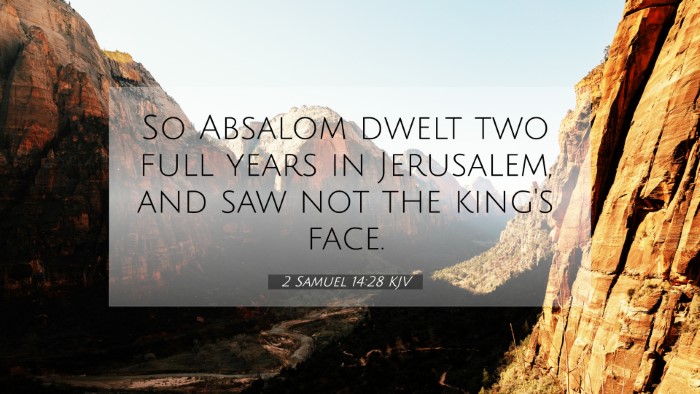Understanding 2 Samuel 14:28
Verse Context: In 2 Samuel 14:28, we find Absalom's return to Jerusalem after being in exile for three years. His return signifies a pivotal moment in the narrative as it sets the stage for the subsequent conflict and rebellion against his father David.
Verse Analysis
According to public domain commentaries, this verse highlights complex familial relationships, reconciliation, and the broader implications of Absalom's return as it relates to King's responsibilities and the dynamics of leadership.
Commentary Insights
-
Matthew Henry:
Henry emphasizes the emotional and political ramifications of Absalom's return. He notes that while David longs for his son, the unaddressed issues from the past create an underlying tension. The return is not merely physical but laden with the baggage of unresolved conflict.
-
Albert Barnes:
Barnes discusses how Absalom's return marks a strategic move in the context of his ambition. He portrays Absalom as a complex character whose actions reflect the broader themes of loyalty, rebellion, and the fracture within the house of David.
-
Adam Clarke:
Clarke offers insights into the cultural and historical background of the time, arguing that Absalom's return signifies not just personal reconciliation but also a public maneuver that could sway political opinion against David.
Cross-References and Thematic Connections
This verse is intricately connected with several other passages, illustrating themes of exile, reconciliation, and conflict. The following Bible verses can provide deeper understanding through cross-referencing:
- 2 Samuel 13:37-39: This passage discusses Absalom's previous flight and provides essential background for understanding his current situation and motivations.
- 2 Samuel 15:1-6: Here, Absalom's growing influence and ambition are discussed, leading to the context for future conflict with David.
- Genesis 4:14: The theme of banishment and longing for family can be traced back to Cain, illustrating the weight of exile within biblical narratives.
- Luke 15:20-24: The Parable of the Prodigal Son provides a New Testament perspective on reconciliation, reflecting similar themes of restoration after estrangement.
- Psalm 3: A psalm of David that expresses his feelings during Absalom's conspiracy, highlighting the emotional turmoil within the family context.
- 1 Kings 1:5-6: Absalom's ambitious nature is further revealed, leading to the climax of the rebellion against David.
- Proverbs 17:1: This verse addresses the value of peace in the household, resonating with David's struggles in his family life.
Tools for Cross-Referencing
Understanding the connections within scripture can be greatly enhanced through various tools:
- Bible Concordance: A critical resource for locating verses and understanding themes.
- Bible Cross-Reference Guide: Helps identify links between scriptures, enhancing the study of interconnected themes.
- Bible Reference Resources: Guides and tools that aid in navigating biblical texts for deeper understanding.
Conclusion
2 Samuel 14:28 serves as a significant turning point in the story of Absalom and David, offering rich themes to explore through cross-referencing. By analyzing this verse alongside others, readers can gain deeper insight into the complex relationships and themes of reconciliation, loyalty, and conflict in the biblical narrative.
For those seeking comprehensive tools and methods for cross-referencing, it is essential to explore the intersection of these verses, which provides a clearer view of both individual and collective scriptural themes.


